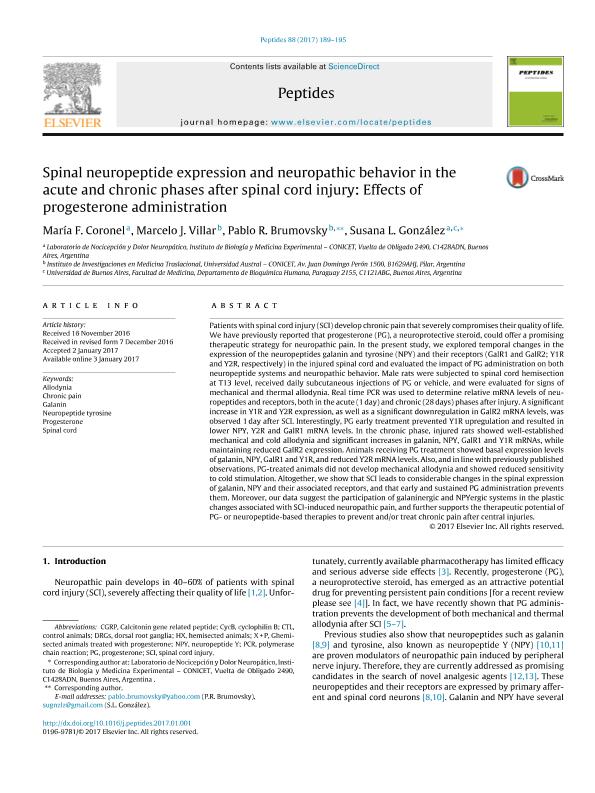Artículo
Spinal neuropeptide expression and neuropathic behavior in the acute and chronic phases after spinal cord injury: effects of progesterone administration
Fecha de publicación:
01/2017
Editorial:
Elsevier Science Inc
Revista:
Peptides
ISSN:
0196-9781
e-ISSN:
873-5169
Idioma:
Inglés
Tipo de recurso:
Artículo publicado
Clasificación temática:
Resumen
Patients with spinal cord injury (SCI) develop chronic pain that severely compromises their quality of life. We have previously reported that progesterone (PG), a neuroprotective steroid, could offer a promising therapeutic strategy for neuropathic pain. In the present study, we explored temporal changes in the expression of the neuropeptides galanin and tyrosine (NPY) and their receptors (GalR1 and GalR2; Y1R and Y2R, respectively) in the injured spinal cord and evaluated the impact of PG administration on both neuropeptide systems and neuropathic behavior. Male rats were subjected to spinal cord hemisection at T13 level, received daily subcutaneous injections of PG or vehicle, and were evaluated for signs of mechanical and thermal allodynia. Real time PCR was used to determine relative mRNA levels of neuropeptides and receptors, both in the acute (1 day) and chronic (28 days) phases after injury. A significant increase in Y1R and Y2R expression, as well as a significant downregulation in GalR2 mRNA levels, was observed 1 day after SCI. Interestingly, PG early treatment prevented Y1R upregulation and resulted in lower NPY, Y2R and GalR1 mRNA levels. In the chronic phase, injured rats showed well-established mechanical and cold allodynia and significant increases in galanin, NPY, GalR1 and Y1R mRNAs, while maintaining reduced GalR2 expression. Animals receiving PG treatment showed basal expression levels of galanin, NPY, GalR1 and Y1R, and reduced Y2R mRNA levels. Also, and in line with previously published observations, PG-treated animals did not develop mechanical allodynia and showed reduced sensitivity to cold stimulation. Altogether, we show that SCI leads to considerable changes in the spinal expression of galanin, NPY and their associated receptors, and that early and sustained PG administration prevents them. Moreover, our data suggest the participation of galaninergic and NPYergic systems in the plastic changes associated with SCI-induced neuropathic pain, and further supports the therapeutic potential of PG- or neuropeptide-based therapies to prevent and/or treat chronic pain after central injuries.
Palabras clave:
Allodynia
,
Chronic Pain
,
Galanin
,
Neuropeptide Tyrosine
,
Progesterone
,
Spinal Cord
Archivos asociados
Licencia
Identificadores
Colecciones
Articulos(IBYME)
Articulos de INST.DE BIOLOGIA Y MEDICINA EXPERIMENTAL (I)
Articulos de INST.DE BIOLOGIA Y MEDICINA EXPERIMENTAL (I)
Articulos(IIMT)
Articulos de INSTITUTO DE INVESTIGACIONES EN MEDICINA TRASLACIONAL
Articulos de INSTITUTO DE INVESTIGACIONES EN MEDICINA TRASLACIONAL
Citación
Coronel, Maria Florencia; Villar, Marcelo Jose; Brumovsky, Pablo Rodolfo; Gonzalez, Susana Laura; Spinal neuropeptide expression and neuropathic behavior in the acute and chronic phases after spinal cord injury: effects of progesterone administration; Elsevier Science Inc; Peptides; 88; 1-2017; 189-195
Compartir
Altmétricas




